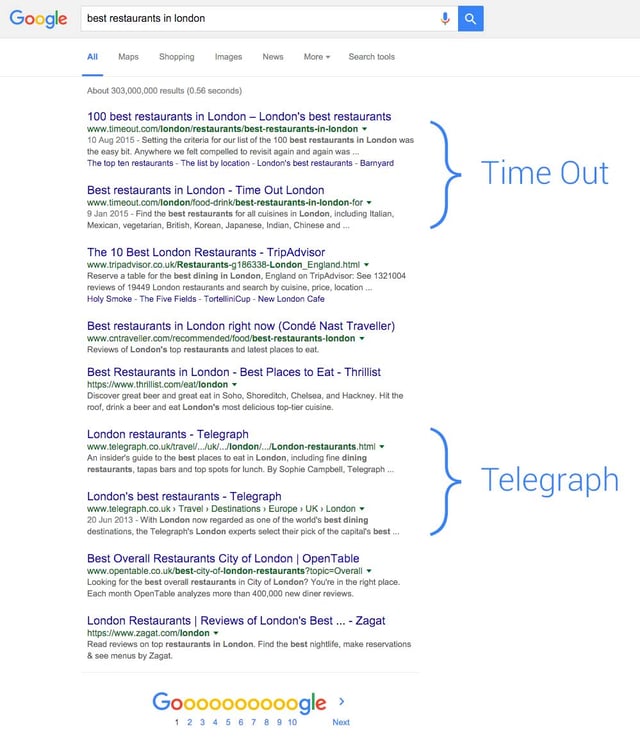Who’s heard the phrase Content is King? Come on, stick your hand up.
My guess is that, over the past few years, virtually everyone reading this blog will have heard that mantra shouted at them from hundreds of digital marketing websites.
However, far too many people think that Content is King means that content is the only thing you need. That if you write good content, hordes of super rich users will descend on your site and shower you with conversions.
Well, that just isn’t true.
Good content is part of the puzzle but it is not, on its own, sufficient to drive long-term traffic growth. If you want results, you’ve got to go out, find some interested eyeballs, you’ve got to make people get excited about what you’re writing.
In this post, I’m going to share five simple strategies to extend the reach of your content and boost your readership.

1. Intelligent Social Scheduling
Your social channels are invaluable tools in your content distribution strategy. You’ve got a collection of people who are already self-proclaimed fans of your business and a direct line to their phone or computer.
However, as social media usage has increased, that direct line has got a whole load less effective.
There’s now 1.5 billion users on Facebook, 400 million on LinkedIn and 300 million on Twitter, and when they all start to jostle for attention, it gets extremely noisy. So while you could try to shout louder than everyone else, it’s an incredibly difficult and expensive strategy.
What we suggest is searching for the lulls, the fleeting quiet spots amid the din and promoting your content then.
But how do you do that?
Well, it’s a two-part process, starting with an analysis of the background noise.
Here’s a glimpse of the general activity on Twitter throughout the day.
Activity predictably peaks around 1 pm when employees are taking a break from their work and falls away during the wee hours when everyone is tucked up in bed.
The peaks on the graph represent the busiest times on Twitter. Everyone is talking and your content is more likely to get lost in the maelstrom. We want to avoid these times like the plague.
What we’re interested in are the dips, the troughs, the hours of the day when folk aren’t hammering away on their keyboards and filling the Twittersphere with micromoments.
However, the dips on their own are not enough. All the dips tell us is that no one is talking. If you scheduled your updates by dips and dips alone, you’d all end up talking to an empty room.
This is where we introduce the second part of the strategy: analysing audience activity.
By analysing your followers, you can identify the times when they are most active and therefore most receptive. To do this we use a handy tool for Moz called Followerwonk.
Followerwonk is a brilliant piece of kit that crawls through your follower list, recording their activity and creates a load of graphs based on their activity.
Here’s what a Followerwonk report for @DigitalImpactUK looks like.
Generally, our users are active in the early morning and late afternoon with a smaller peak at around 8 pm.
Looking back at the general activity on Twitter, general activity tops out at the midpoint of the working day, precisely when our users aren’t interacting. Conversely, our users are active at the start and end of the working day, which are both periods when general activity is lower.
It’s those cross over points you want to target when your users are interacting but there’s less content to interact with. That gives you the greatest chance of being seen and having your content read.
Analyse your audience on Followerwonk, compare that with a graph of the general activity and highlight your very own social sweet spots.
2. Data Capture & Email Marketing
Very few things in life are free. Email marketing, you might be surprised to learn, is one of those things. (Okay, technically all email marketing is not free but services like MailChimp have outstanding free tiers, allowing you to send 12,000 emails to 2,000 contacts per month!)
While email marketing seems to have fallen out of fashion with trendy digital marketing folks, a quick glance at the industry leaders will show you that it is anything but a dead medium. They know that a user who voluntarily signs up for updates is an easy win.
Take a look at Backlinko, the digital marketing blog of Brian Dean.

The first thing you see when you come onto the site is a huge fullscreen data capture point. Before you even know who Brian Dean is, you’re being asked if you want exclusive traffic tips. Well, do you? If you want your website to succeed, you better sign up now.
A quick circuit around some similar blogs - Neil Patel, Quick Sprout, etc - and it’s obvious that the fullscreen signup is catching on.
It’s not that surprising that almost all successful marketing blogs have a liberal scattering of data capture points scattered. A user who voluntarily signs up for emails is a user they no longer have to reach.
Think about Backlinko. If you sign up to Brian's mailing list, he doesn't have to pay to reach you. He doesn't have to work with influencers to get his content shared to your feed. He doesn't have to personally outreach his content to communities you frequent. He doesn't have to promote posts on social media.
All he has to do it type up an email and click send. Subscribers are as easy a win as easy wins get.
3. Google Loves Re-Publishing
Back in October 2015, Moz’s Rand Fishkin presented a Whiteboard Friday on re-publishing. The video is quite complicated but the main message was this: Google loves re-publishing.
But before we delve into the world of re-publishing, a little bit of scene setting. Rand tells us about an example website he set up called Rand’s Furry Friends. It’s a website all about pets and sadly doesn’t actually exist. (Yep, I checked.)
Rand’s story goes like this. Back in 2010, Rand wrote a page called Guinea Pig Food, which gave loads of helpful info about a guinea pig’s diet and general nutritional requirements.
The page was pretty successful and racked up some decent traffic. However, over time, the activity tailed off. Rand is now looking for a way to refresh his content and kickstart his stats.
To take advantage of Google’s love for re-publishing, Rand proposes three strategies: Piggybacking, Replacing, and Redirecting.
Piggybacking
Piggybacking relies on a weird feature in Google’s SERPs. Basically, if there are two results from the same website on the same results page, they won’t be displayed apart from each other.
Here’s an example search for best restaurants London.

The first and second results are both from Time Out and the fifth and sixth results are from the Telegraph. Try some searches for yourself and see if you can find results from the same URL split apart in the SERPs.
Piggybacking uses this quirk to exploit the power of existing high-ranking content to pull new content up the results page. Here's how Rand explains it:
“… multiple pieces that are published one after another—that time frame could be anything between them—targeting slight keyword variations and slight content variations. So right here I've got the 10 foods your guinea pig will love and guinea pig food, just the broad article.
The idea, hopefully, what I really want to do is get one of these ranking in the top two or three results. Then once I produce the other one, if it ranks on page one, we know how Google treats that. They'll put it directly below. So they won't have you rank number two and you rank number eight. No, you'll rank number two, and if you rank number eight, boom, they'll bump you up to rank number three.
Your republished content piggybacks on the success of your existing content, jumping past competing pages in the rankings and 'sticking' together. By sticking together these pieces of content form a branded block which dominates a chunk of the SERPs, maximising your visibility and generating higher click-through-rates.” –Rand Fishkin, Whiteboard Friday
Replacing
If I look back at some of my early blogs, they make me cringe. The formatting is off, the tone is wonky and the imagery is from another planet. And that’s because I simply wasn’t as good a content writer then as I am now.
But that’s part of learning. As you practice a skill, your finished work gets better. Whether it’s a blog, concerto, website design or code, it’s the same story.
The good news is that going back and fixing old content isn’t just a vanity project, it can give your content a boost too. It gives you a second shot, a second chance to promote your content, another go at interesting eyes and earning links.
“… I've produced XA, and I'm going to replace it with XB … The idea being I'm updating and improving that content. I have a second chance at earning links, earning amplification signals, and hopefully getting better engagement. Maybe if I'm already ranking well, I can improve that.”
“Replacing old content is the simplest technique of the three but don't think it's any less effective.” –Rand Fishkin, Whiteboard Friday
Trawl through your old content, find something you’ve created, improve it and promote it again.
If you’re updating old posts, remember to update the post date too -- Google really likes fresh content!
Redirecting
Generally speaking, there’re two types of content: evergreen and trending. Whereas evergreen topics are always interesting to your readers, trending topics target something time sensitive.
An introduction to the rules of American Football is an evergreen topic and a preview to Super Bowl 50 is a trending topic.
While trending content is much more likely to hit the sweet spot and go viral, it’s a dead donkey once the trend has died down.
For example, earlier this year security analysts discovered a security glitch in WordPress. I wrote a blog about it, urging people to update to the newest version of the platform.
That blog was pretty successful. It got a couple of shares, a few links and even a thank you email. However, several months later, that content is meaningless. It’s like an old blog on the dangers of the Millennium Bug - it just isn’t relevant to your readers anymore. No one cares about a security issue that’s been fixed.
For content like this Rand recommends his third and final re-publishing strategy: redirecting.
“I can redirect old content to new. So potentially I can say, "Hey, you know what? I'm producing this new piece on 10 neat foods your guinea pig will love. This old article I just don't love anymore, but I want to get the rankings benefit and all the signals to this new page that this old one has." So all these links and wonderful things that were coming in here, I want to redirect them, and so I'm going to use a 301 to point A over to B.
“Redirecting old content allows you to scoop up all the authority attached to it and pass it onto something else, boosting the new blog's authority and improving its performance in SERPs.” –Rand Fishkin, Whiteboard Friday
4. User Generated Content
Consider this. The average Twitter account is followed by 208 people. If this average Twitter account tweets an average tweet, it is seen by a maximum of 208 people. Good but certainly not great.
If, however, you can convince those 208 to retweet your content to their contacts, you have access to each of their 208 followers. That’s a maximum of 43,264 people.
Convincing your followers to share your content is known as amplification and it can convert the smallest of dedicated communities into a content distribution powerhouse.
So how do you convince your followers to become content amplifying machines? Three simple words: user generated content.
User generated content makes your followers part of your content creation process, which in turn makes them part of your distribution strategy.
Here’s an example.
Last year I wrote my first guest post for internet marketing supremos Moz. I slaved over that post, drafting, redrafting, polishing and proofing it until it was perfect. As soon as it went live on Moz, I was promoting it to within an inch of its life.

I emailed every single marketing influencer I knew. I rewrote segments and syndicated them out as guest posts. I responded to every single comment, no matter how mundane. I took the post to every online marketing community I knew of.
In short, I went on an outreach offensive.
Moz didn’t have to ask me to do any of this either. I wanted to do it.
You see, that blog was something I had written on a platform I respected. There’s no better motivation than that.
How you generate user generated content is hugely dependent on your business. If you need some inspiration, check our Burberry’s Art of the Trench, Starbuck’s White Cup Contest or Tourism Australia’s Best Job in the World campaign.
They’re all brilliant in their own way and all harness the power of their respective communities.
5. Segment and Syndicate
“And we retain sole publication rights, yes?” read an email I received in reply to a prospective guest blog pitch.
“No, you most certainly don’t,” read my reply.
If I write good, unique, valuable, link-worthy content, I own it. It’s mine and I don’t plan on just giving it away.
If you slave away on a blog or article for hours upon hours, you should never (very particular circumstances omitted) give it away for one paltry link.
Here’s a quick example.
One of the first blogs I wrote for Digital Impact was about all the best free stock photo sites on the web. It took an exceedingly long time to trawl through pages of search results, blogs and listicles, cherry picking the best of the best and writing them up into a colossal 2700-word monster.
When I posted the blog, Digital Impact was still in its infancy. We had a completely fresh domain and it was super tempting to shop the article out to some DA50 site and enjoy the authority boost.
However, we resisted the temptation and instead of pitching it to one, we chopped it up and sold the chunks to multiple sites.
Parts of that original blog are now featured on sites, including TechWyse (DA: 56) and LinkBird (DA:48). The original is still on our blog and has attracted dozens of valuable links to our own homepage.
If you shop a blog like that out in its entirety, you get a single lonely link. Plus, any extra promotion you do for your blog mostly helps out the site which published it. That’s hardly fair, especially when you start to think about all the hours you’ve sunk into it!

